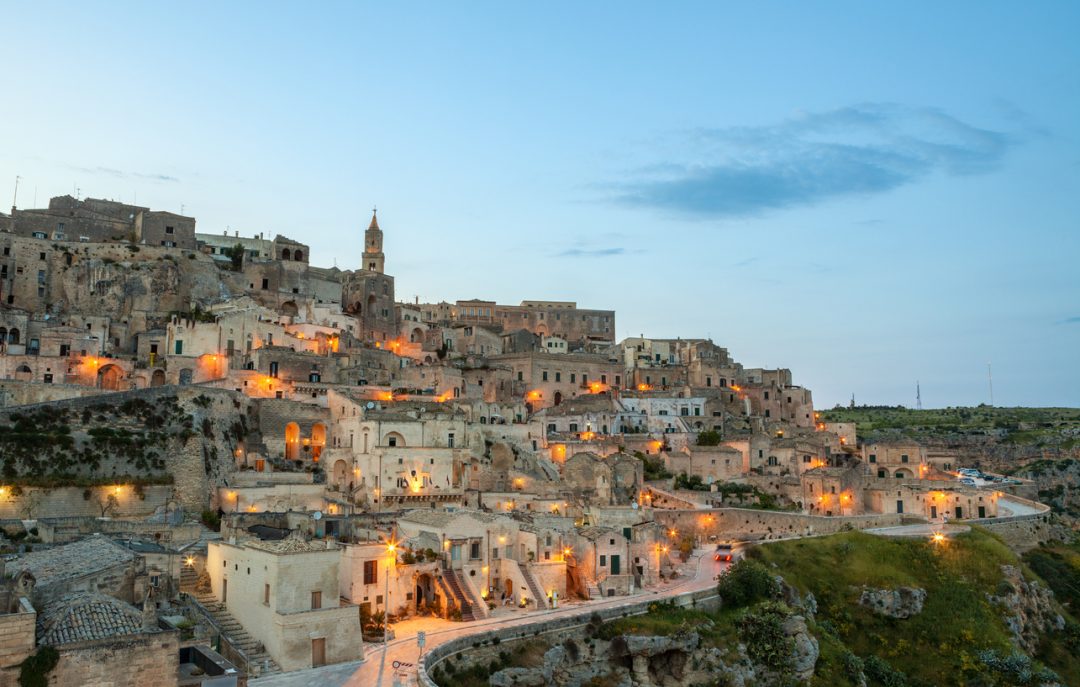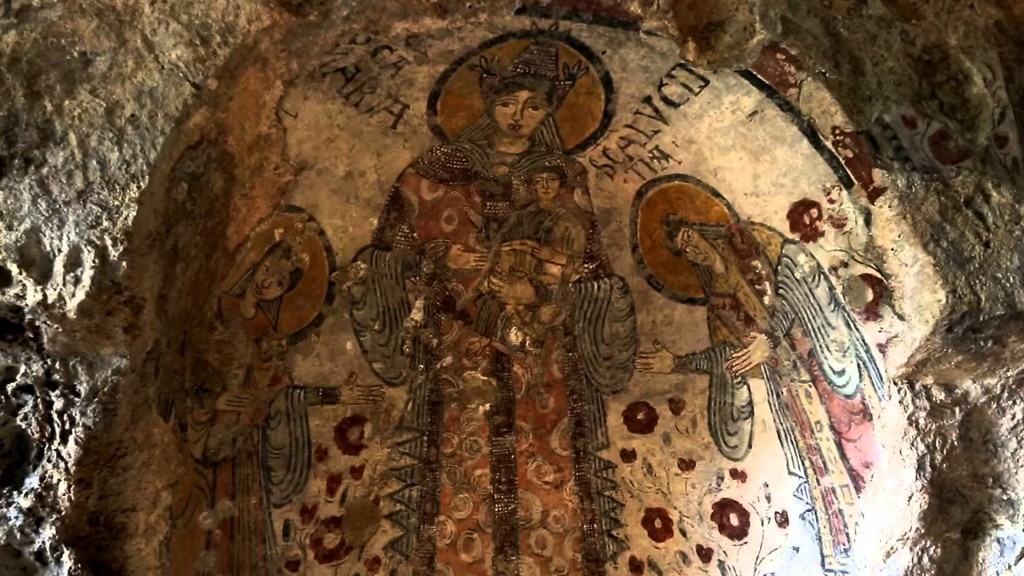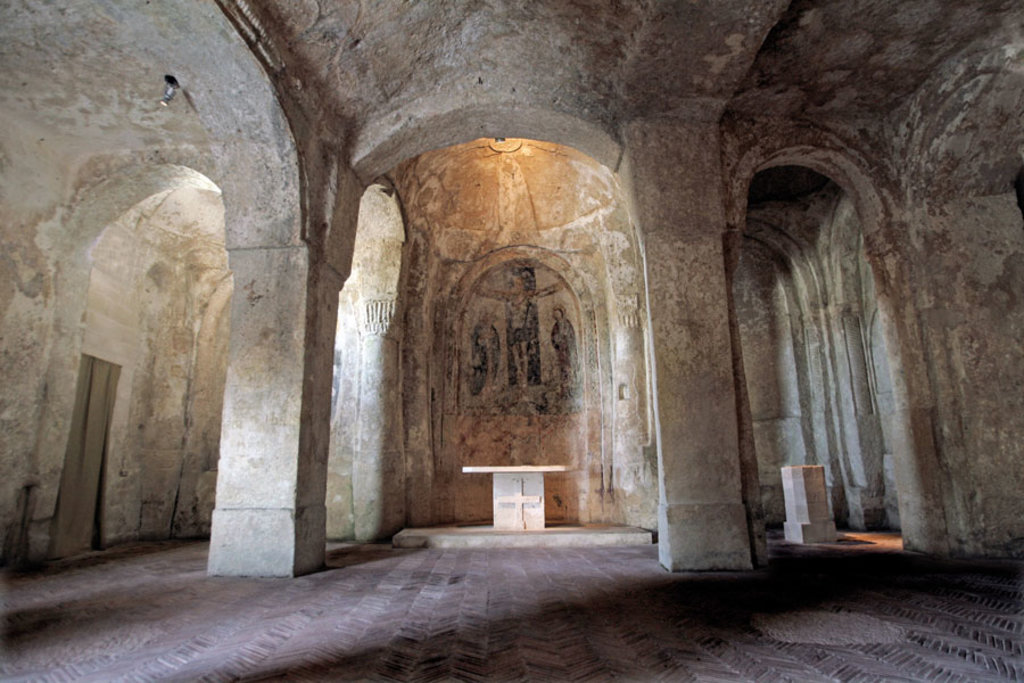
Ancient dwellings carved into the tuff. A deep ‘valley’ (ravine) crossed by a stream. Roofs that become floors for the dwellings on the upper levels. A dense network of alleys, and the impression of walking in
a papier-mâché nativity scene. All this is Matera, in Basilicata, European Capital of Culture 2019, whose rock churches and famous ‘Sassi’ – a peculiar settlement form carved out of the rock – were included in the UNESCO World Heritage List in 1993.
Matera: the City of Stone and the Treasure of its Rock Churches

To stroll through the historic centre of Matera is to step back in time. The area where the city stands was already inhabited in the Palaeolithic period, when the first settlements were established in the calcarenite caves of the mountain. The human ecosystem, perfectly integrated into the surrounding natural environment, has been perpetuated over the centuries with various adaptations to the different historical periods, from the first underground dwellings to the sophisticated later urban structures, built with excavated materials, an exceptional example of accurate use of natural resources.
The area of Matera, so evocative that it has earned the nickname ‘the second Bethlehem’, has inspired writers, artists and directors over the centuries, such as Pier Paolo Pasolini and Mel Gibson, who chose it as the setting for his ‘Passion of the Christ’.
In the 1950s, the people who lived in the caves were moved to modern quarters and the Sassi underwent a comprehensive renovation that restored them to their original beauty. Today, one of the oldest and most important areas is the Civita district, a natural fortress located in the heart of the ancient city, which, together with the two depressions of the Sasso Barisano and the Sasso Caveoso, constitutes the most fascinating part of the ‘city of stone’ with its Romanesque cathedral undergoing renovation. The Sasso Caveoso preserves almost completely intact the dwellings carved into the rock, especially in the final part, which flows into Via Casalnuovo. From the main square, with the beautiful Church of San Pietro Caveoso, there is an exceptional view of the ravine below, with its labyrinth of streets, churches and dwellings clinging to the slopes. Instead, walk along Via Madonna delle Virtù to reach the Sasso Barisano district, which, among other tourist attractions, houses a reconstruction of the Sassi in miniature and the Museum of Rural Civilisation.
Among the many rock churches in Matera, which combine the barren charm of the rock with the refinement and elegance of the interior decorations, the imposing Church of San Pietro Barisano, the Church of Santa Lucia delle Malve, the rock complex of the Convicinio di Sant’Antonio are worth a visit, the churches of Santa Maria de Idris and San Giovanni, the Church of Santa Barbara with its splendid frescoes and, finally, the rupestrian complex of Madonna delle Virtù and San Nicola dei Greci, between the Sasso Caveoso and the Sasso Barisano, which hosts an important international sculpture exhibition every year.
The places of worship that are part of the Parco delle Chiese Rupestri del Materano (Park of the Rock Churches of Matera), however, are many more and are scattered throughout the surrounding territory, between the municipalities of Matera and Montescaglioso. The Park covers about 8,000 hectares and has more than 150 rock churches, as well as numerous settlements dating back to the Palaeolithic period, such as the Grotta dei Pipistrelli, and Neolithic artefacts, such as the ceramics of Diana Bellavista and Serra d’Alto.

The Artezeta cooperative manages one of the territory’s most relentless rock churches, also known as the ‘Sistine Chapel’ of rock wall painting: the Crypt of Original Sin.
This exceptional rock oratory represents one of the oldest examples of rock art in southern Italy. Its extraordinary cycle of frescoes, created five hundred years before Giotto, highlights the typical features of Benedictine-Benevan art (8th-9th centuries).
The humble fresco painter, remembered as the Painter of the Flowers of Matera, illustrated on the back wall the biblical account of the first chapters of Genesis: God the Father Creator, Light, Darkness, the creation of Adam, the birth of Eve, the temptation and Original Sin. The story of Creation then leaves room, in the three apsidal basins, for the splendid triarchies of the Apostles (Peter, Andrew and John), the Archangels (Michael, Gabriel and Raphael) and the veneration of the Virgin Queen.
The precious cycle of frescoes, ignored and abandoned for years, was finally recovered thanks to the Zétema Foundation’s project, with the consultancy of the Central Institute for Restoration and the participation of committed professionals. This was not a simple restoration project, but a scientific reference model, a code of practice for future interventions on the world’s rock heritage.
Restoration of the crypt was made possible thanks to funding from the CARIPLO Foundation of Milan, CARISBO of Bologna and the Cassa di Risparmio di Piacenza e Vigevano in the context of ACRI’s Sviluppo Sud project, and the collaboration of the Dragone family, on whose property the Crypt of the Original Sin is located.
[If you plan to visit the city of Matera and its area perhaps you might be interested in taking a look at what else there is to see in Matera and the museums not to be missed.


articolo esaustivo e molto interessante ,scritto con cura e dedizione.
Articolo davvero interessante. Complimenti allo/a scrittore/scrittrice per il grande lavoro e contributo che aiuta i giovani ad essere più acculturati e saperne di più del luogo in cui vivono!
BELLISSIMO